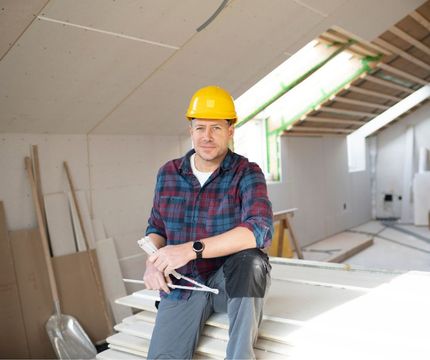Reliable Drywall Installation Solutions for every single Area
Reliable Drywall Installation Solutions for every single Area
Blog Article
Drywall Setup Made Easy: Tips for Perfect Results
Drywall installation is frequently perceived as an overwhelming job, yet with the appropriate technique and expertise, it can end up being a workable venture. Mastering techniques for cutting, hanging, and completing drywall can considerably impact the result.
Choosing the Right Materials
Picking the proper materials for drywall installment is important to accomplishing a sturdy and aesthetically pleasing surface. drywall installation. The key component, drywall sheets, normally been available in various densities, with 1/2-inch sheets being common for interior walls. For areas needing added moisture resistance, such as shower rooms or kitchen areas, consider using eco-friendly board or cement board, which are specifically designed to hold up against moisture

Additionally, picking the ideal fasteners-- either nails or screws-- is vital for securing the drywall to the framing. Drywall screws are generally preferred for their holding power and reduced danger of standing out. Lastly, consider the complements such as guide and paint, which not only boost the appearance but likewise protect the drywall from wetness and wear.
Preparing the Setup Location
Before starting the drywall installment procedure, it is vital to prepare the installment area completely. A tidy work area decreases the risk of damage to existing products and enables for reliable motion during setup.
Following, inspect the wall surfaces and ceiling for any imperfections, such as fractures, holes, or mold. Address these concerns beforehand; patch any damages and enable adequate time for repair services to completely dry. Additionally, guarantee that electric outlets, switches, and plumbing are effectively positioned and accounted for, as this will certainly impact drywall placement.
Think about the environmental conditions too. A steady temperature and humidity level are vital for ideal adhesion and performance of the drywall materials. If necessary, use a dehumidifier or heating system to produce appropriate problems.
Cutting and Hanging Drywall
The key to effective drywall installation lies in the precise cutting and hanging of the panels. Begin by determining the room properly, taking into account any type of blockages such as electric outlets or home windows. Use a straight side and an utility knife to score the drywall along your measurements, then snap it along the racked up line for a clean break. For more intricate cuts, such as around outlets, a drywall saw can be used for precision.

Constantly work from the top down and left to right, guaranteeing that you keep a staggered pattern to enhance security. Correctly hanging the drywall sets the foundation for a smooth surface, ultimately causing remarkable outcomes in your drywall task.
Insulation and Mudding Techniques
While appropriate cutting and hanging of drywall sets the phase, the following vital step entails mastering taping and mudding methods to ensure a smooth coating. Insulation is crucial for enhancing joints and preventing splits; it includes embedding click this link tape into the applied joint compound (mud) Start with a quality fiberglass or paper tape, applying the tape over the joint and pressing it right into the wet mud utilizing a taping knife, guaranteeing no air bubbles stay.
As soon as the tape is in place, apply a slim layer of joint substance over the tape, feathering the sides to create a smooth change to the drywall surface. Enable this layer to completely dry totally prior to sanding it lightly to eliminate flaws. Repeat this procedure, applying extra layers of mud as essential-- normally a couple of layers-- while progressively widening the application location with each layer to attain a seamless appearance.
After the last coat dries, sand the surface with a fine-grit sandpaper up until smooth. drywall contractor. Remember to use a mask throughout fining sand to avoid inhaling dust bits. Understanding these taping and mudding strategies is vital for accomplishing a professional-quality finish in your drywall setup
Finishing Touches for Excellence
Achieving a remarkable drywall setup exceeds mudding and taping; it finishes in the completing touches that elevate the overall appearance. These last steps are important in guaranteeing a professional-grade coating that enhances the looks of your area.
Begin by sanding the dried out joint compound to create a smooth surface. Use a fine-grit sandpaper and a fining sand block or post sander for ideal control. Pay particular focus to sides and edges, as these areas often tend to need even more thorough work. After fining sand, wipe down the walls with a wet towel to get rid of any kind of dust fragments, making sure a tidy surface area for painting.
Next, use a primer specifically designed for drywall. This step is important, as it aids secure the joint substance and gives a consistent base for the topcoat. Once the primer dries out, inspect for any type of flaws, and touch up as required.
Conclusion
To conclude, successful drywall installation depends upon the cautious option of products, complete preparation of the setup area, and accurate execution of reducing and hanging strategies. Mastery of taping and mudding processes is necessary for accomplishing a smooth surface. Additionally, attention to completing touches, including priming and touch-ups, ensures a professional-grade outcome. By sticking to these standards, the top quality of workmanship can be dramatically enhanced, adding to the total visual and capability of the area.
Drywall setup is usually perceived as a complicated job, yet with the ideal approach and understanding, it can become a convenient endeavor.Choosing the appropriate products for drywall installation is critical to accomplishing a resilient and cosmetically pleasing surface.Prior to beginning the drywall installment process, it is essential to prepare the installment area extensively. Understanding these taping link and mudding this website methods is vital for accomplishing a professional-quality surface in your drywall setup.
In verdict, successful drywall installation hinges on the cautious selection of materials, comprehensive preparation of the setup location, and accurate implementation of cutting and hanging strategies.
Report this page